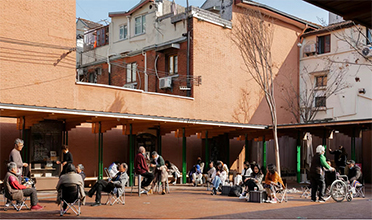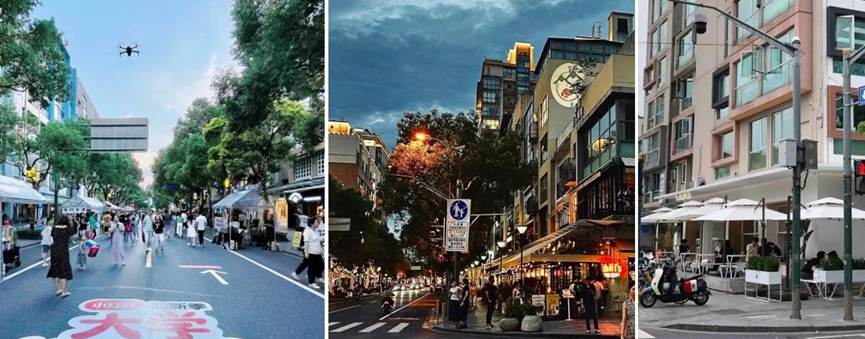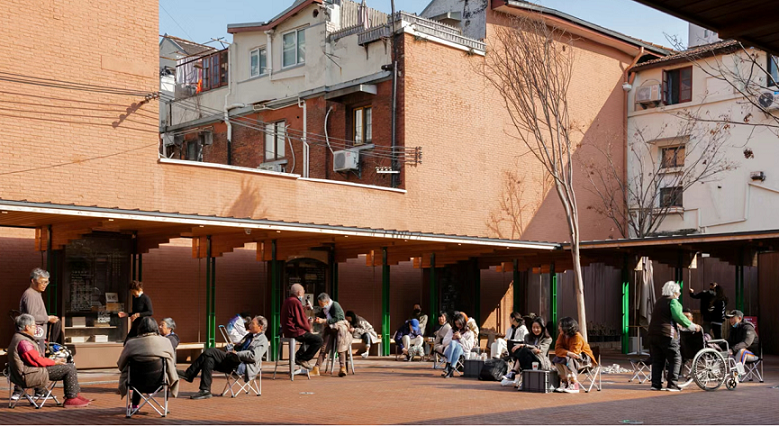


2.3 "Use" - close to people's daily function and use
"Use" is mainly reflected in the support of daily public activities, trying to make the public space and its surrounding environment close to daily life through mixed functions, diverse activities, and multi-cultural exchanges for residents to exercise and communicate.
Urban designers can stand in the position of the public rather than individual projects to design the layout of public space and functions and uses of surrounding areas, in order to lead and promote public interests and residents’ life through extensive social research. In the case of the commercial complex mentioned above, the design team mainly relied on the research and analysis of the daily activities and consumption preferences of the citizens and tourists in the certain area, and adjusted the functional interfaces of the streets and plazas in the overall layout. By weakening the negative impacts of the vehicular entrances and exits, freight transportation routes, fire-fighting machinery and electrical equipment, as well as the garbage disposal facilities, and emphasizing the mass consumption storefronts and the cultural and leisure activity spaces, create a comfortable environment of daily life.
"Episodic activity" is often an important indicator of the "usefulness" of a public space, and is highly variable under different environmental conditions. Under poor environmental conditions, episodic activities have a very low probability of occurring compared to necessary activities. But once the space is attractive, episodic activities can happen very often. The transformation of University Road (Fig. 9) in Yangpu District, Shanghai, from a planned road to a must-visit popular street nowadays is a good example of the key impact of mixed functions on the vitality of public space in urban design.

Figure 9: The University Road, Yangpu District, Shanghai
Functional mixing can promote the vitality and frequency of using the public space, and is also a major breakthrough from the established urban land use and planning technical regulations. The activity of public space cannot be separated from the diversified neighboring functions and people. The original single land use pattern and planning idea need to have a breakthrough, and the possibility of mixing functions is needed in both horizontal and vertical directions. Nowadays, many projects are allowed to mix residential, office, commercial, and other functions in the certain area, which brings a lot of trouble to the management of property rights, but can bring more convenience to the daily public life close to the citizens.
2.4 "Field" - a place where people have memories of emotional dependence
"Field" is the place (genius loci), originally refers to the guardian god of the specific place, and then was extended to the sense of belonging to the site of identity and sense of place, especially refers to the unique temperament, atmosphere, and spirit of a certain place. The public space close to the daily life of the people must be a place that can transfer people’s memory and emotions, through stories, legends, atmosphere, characteristics, and so on, to make people feel the emotional attachment and belonging in the urban public space.
Take the Yuegang area in Zhangzhou, Fujian Province as an example, it was an important starting point of the Maritime Silk Road in the Ming Dynasty, and has deep historical and cultural deposits, with existing historical buildings and sites that have changed over the years, but still show traces of the prosperity of the "Great Seafaring" era. The urban design of the Yuegang area, through clarifying the history, and excavating the local cultural characteristics, regenerate the historical area to a modern district on the basis of grasping the key historical patterns. Defining the boundaries of the renewal of the old city through the ring road, protecting the ignored city road structure, important architectural remains, and the Yuexi waterway which was the busiest in ancient days, so that the system and nodes of public space become a means to convey historical memories and many places of interest. At the same time, it responds to the needs of urban development and life, transforming the previous life of "living with the water at the back of the city" to actively "living with the water through urban life", and by building new constructions and novel public spaces. The "Maritime Silk" culture and story scenes inherited from the old buildings is now transferred to the new public spaces, and will be presented in the daily life of the citizens.
In contrast to the "field" of historical heritage, the Yongjia Road Pocket Park in Shanghai (Figure 10) is a "delicate happiness" brought about by the provision of public space in the cracks of the streets in the urban regeneration process. Such a small park has become a "field" of life for the residents living in the community to rely on for their daily emotional support and the sense of belonging and identity. Everyday humanistic care can be reflected in these tiny unintentional details in the public space, community residents naturally converge here from the surrounding neighborhood, sunbathing, communicating with each other, chatting different topics, or dreaming with curious young people, which creating a full and happy day for the ordinary people, and such daily "warmth" is the most important part of the public space. This kind of daily "warmth" is the most demanded in the public space, and is also the most important thing that needs to be emphasized in our city.

Figure 10. the Yongjia Road Pocket Park
3 Conclusion
The creation of good public space involves many aspects, but daily "warmth" is the key connotation, as long as the planners and architects start from the real and specific person, and devote their efforts to do the planning and design for them, they can definitely make a difference. Urban construction is always an overlap of the work of planners and architects, and the complementary interaction of planning and design thinking is especially reflected in the creation of public space. It is hoped that the four points of "path, space, use and field" will help to create better people-oriented public spaces.
Author: Zhuang Yu,Professor, College of Architecture and Urban Planning, Tongji University; Vice Chairman, Urban Design Branch, Urban Planning Society of China
Source:<https://mp.weixin.qq.com/s/OZPM796fBy4c-7Pfim5SYg>
Translated by Zhang Chenxi